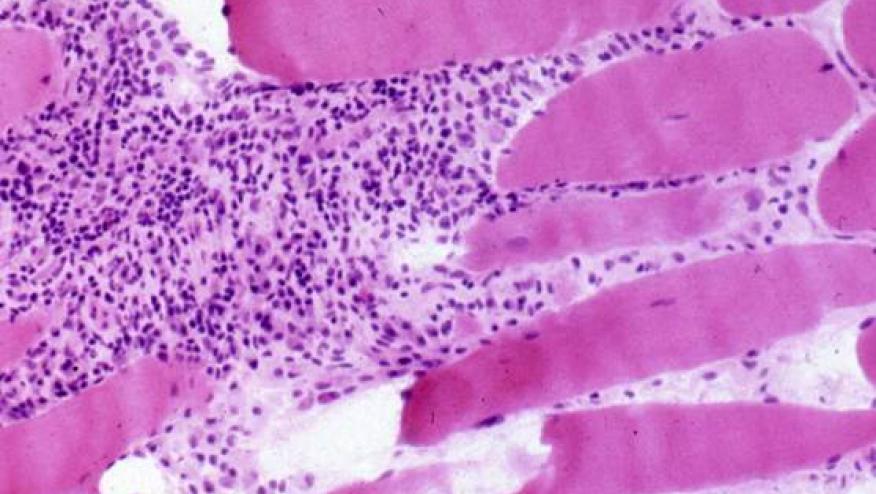Idiopathic Inflammatory Myopathy Quadruples Death Risk Save

A Swedish population-based study found a nearly fourfold greater risk of all-cause mortality in idiopathic inflammatory myopathy (IIM) patients compared with the general population.
Risk peaked to almost 10% in the first year, pointing to the need for careful monitoring of newly diagnosed patients, reported Marie Holmquist, MD, PhD, of the Karolinska Institute in Stockholm, and colleagues in Annals of the Rheumatic Diseases.
The researchers compared outcomes in 716 national healthcare registry patients (55.2% women) diagnosed with IIM during the period 2002-2012 and 7,100 matched members of the general population.
The major subsets of IIM – polymyositis (PM), dermatomyositis (DM), and sporadic inclusion body myositis (sIBM) – are considered treatable, but many patients respond poorly to immunosuppressive treatment. Muscle impairment and damage to other organs such as the lungs are frequent complications.
Holmquist and colleagues noted that previous studies of this uncommon disease have reported wide variations in mortality estimates, with 10-year survival rates ranging from 18% to 90%. Previously, in the largest population-based IIM mortality study to date, 326 Norwegian IIM patients diagnosed during 2003- 2012 were found to have standardized mortality ratios of 2.4, 2.6, and 1.7 versus the general population for PM, DM, and sIBM, respectively.
And in 2016, a Johns Hopkins study of IIM patients diagnosed during 2005-2014 reported markedly lower mortality rates than previous research. In those without interstitial lung disease (ILD), survival rates at 1, 5, and 10 years were 99%, 95%, and 90%, respectively. In those with ILD, the corresponding survival rates were 97%, 91% and 81%.
"But these patients were actively monitored in a specialized rheumatology clinic, where they received optimal treatment and follow-up," Erin Mary Bauer, MD, of Virginia Mason Medical Center in Seattle, told MedPage Today. "The patients in the Swedish study are likely more representative because the reality is that not all IIM patients are carefully followed up."
According to Bauer, the infrequency of IIM makes it difficult to accumulate sufficient numbers of patients to studies. "It's so rare that we don't actually have any formal guidelines and it's hard too say what optimal treatment or follow-up is. There's no consensus."
Bauer said the Swedish study is unlikely to alter U.S. practice and in fact supports the current approach, which involves a thorough malignancy and pulmonary workup at time of diagnosis. It does, however, underscore the need for guidelines on the frequency of screening. "For now, we should continue to be vigilant in screening at diagnosis for cancer and underlying pulmonary disease and continue to keep a close eye on patients, although it's unclear just how close that needs to be."
Study Details
Mean age at the beginning of follow-up was similar in both groups at approximately 61 years, and about 40% had 10 to 12 years of education.
With median follow-up periods of 4.6 years for the IIM cohort and 6.0 years for general population members, 224 (31%) of the IIM cohort and 870 (12%) in the general population died.
This corresponded to a crude incidence rate of 59.9 (95% CI 42.0-77.8) deaths per 1,000 person-years in IIM patients versus 19.8 (95% CI 16.5-23.1) deaths per 1,000 person-years in the general population. The mortality rate rose with age in both cohorts and declined with increasing educational level. While rates were similar for both sexes in the IIM cohort, they were higher for men in the general population.
Risk peaked in the IIM cohort during the first 12 months. One year post-diagnosis, the cumulative mortality was 9% in IIM and 1% in the general population. The overall hazard ratio for death in IIM versus the general population was 3.7 (95% CI 3.2-4.4). Mortality risk remained double that in the general population more than 10 years post-diagnosis.
The IIM cohort also died younger than the general population at a mean age of 73 (SD 11) versus 79 (SD 10), and more of those dying were women: 56% versus 47% of the general population.
Apart from musculoskeletal and connective tissue diseases, the principal causes of death in the IIM cohort were malignancies and circulatory and respiratory diseases, in the first year after diagnosis, and these were also the main causes in the general population.
Owing to overlapping International Classification of Disease 10 (ICD-10) codes, only outcomes for DM subtype could be analyzed separately, while other subtypes were treated as a group.
IIM has elsewhere been strongly linked to heightened cardiovascular disease risk.
One limitation of the study was the acknowledged overlap of ICD-10 codes permitting separate analysis for DM but not for other subtypes. An additional limitation was the absence of clinical information on myositis-specific autoantibodies, muscle biopsy features, and other phenotypes, assessment of which would have strengthened results. And since Swedish autopsy rates have declined in the past 20 years, some non-differential misclassification of outcome by cause-specific death could have reduced the size of the true association between IIM and mortality.










If you are a health practitioner, you may Login/Register to comment.
Due to the nature of these comment forums, only health practitioners are allowed to comment at this time.